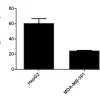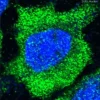- Empty cart.
- Continue Shopping

Human Insulin ELISA Kit
Human Insulin ELISA Kit
This product is currently out of stock and unavailable.
Key features and details
- Sensitivity: 4 µlU/ml
- Range: 4.69 µlU/ml – 300 µlU/ml
- Sample type: Cell culture supernatant, Plasma, Serum
- Detection method: Colorimetric
- Assay type: Sandwich (quantitative)
- Reacts with: Human
Overview
Product name
See all Insulin kits
Detection method
Sample type
Assay type
Sensitivity
Range
Recovery
89 %
| Sample type | Average % | Range |
|---|---|---|
| Cell culture supernatant | 76.16 | 68% – 88% |
| Serum | 91.4 | 83% – 102% |
| Plasma | 99.03 | 73% – 128% |
Assay duration
Species reactivity
Predicted to work with: Mouse, Rat, Cow, Pig
Product overview
Abcam’s Human Insulin ELISA (Enzyme-Linked Immunosorbent Assay) kit is an in vitro enzyme-linked immunosorbent assay for the quantitative measurement of Human Insulin and Proinsulin in serum, plasma, cell culture supernatants.
This assay employs an antibody specific for Human Insulin coated on a 96-well plate. Standards and samples are pipetted into the wells and Insulin present in a sample is bound to the wells by the immobilized antibody. The wells are washed and biotinylated anti-Human Insulin antibody is added. After washing away unbound biotinylated antibody, HRP-conjugated streptavidin is pipetted to the wells. The wells are again washed, a TMB substrate solution is added to the wells and color develops in proportion to the amount of Insulin bound. The Stop Solution changes the color from blue to yellow, and the intensity of the color is measured at 450 nm.
This kit detects both insulin and proinsulin.
Get higher sensitivity in only 90 minutes with Human Insulin ELISA Kit (ab200011) from our SimpleStep ELISA® range.
Notes
Optimization may be required with urine samples.
Platform
Properties
Storage instructions
| Components | 1 x 96 tests |
|---|---|
| 20X Wash Buffer | 1 x 25ml |
| 500X HRP-Streptavidin Concentrate | 1 x 200µl |
| 5X Assay Diluent B | 1 x 15ml |
| Assay Diluent A | 1 x 30ml |
| Biotinylated anti-Human Insulin | 2 vials |
| Insulin Microplate (12 strips x 8 wells) | 1 unit |
| Recombinant Human Insulin Standard (lyophilized) | 2 vials |
| Stop Solution | 1 x 8ml |
| TMB One-Step Substrate Reagent | 1 x 12ml |
Research areas
- Signal Transduction
- Growth Factors/Hormones
- Insulin / Insulin-like
- Neuroscience
- Neurology process
- Metabolism
- Signal Transduction
- Metabolism
- Lipid metabolism
- Cancer
- Growth factors
- Insulin and insulin-like
- Cardiovascular
- Atherosclerosis
- Diabetes associated
- Kits/ Lysates/ Other
- Kits
- ELISA Kits
- ELISA Kits
- Growth factors and hormones ELISA kits
- Metabolism
- Types of disease
- Diabetes
- Metabolism
- Types of disease
- Obesity
- Metabolism
- Types of disease
- Heart disease
Function
Involvement in disease
Defects in INS are a cause of diabetes mellitus insulin-dependent type 2 (IDDM2) [MIM:125852]. IDDM2 is a multifactorial disorder of glucose homeostasis that is characterized by susceptibility to ketoacidosis in the absence of insulin therapy. Clinical fetaures are polydipsia, polyphagia and polyuria which result from hyperglycemia-induced osmotic diuresis and secondary thirst. These derangements result in long-term complications that affect the eyes, kidneys, nerves, and blood vessels.
Defects in INS are a cause of diabetes mellitus permanent neonatal (PNDM) [MIM:606176]. PNDM is a rare form of diabetes distinct from childhood-onset autoimmune diabetes mellitus type 1. It is characterized by insulin-requiring hyperglycemia that is diagnosed within the first months of life. Permanent neonatal diabetes requires lifelong therapy.
Defects in INS are a cause of maturity-onset diabetes of the young type 10 (MODY10) [MIM:613370]. MODY10 is a form of diabetes that is characterized by an autosomal dominant mode of inheritance, onset in childhood or early adulthood (usually before 25 years of age), a primary defect in insulin secretion and frequent insulin-independence at the beginning of the disease.


























